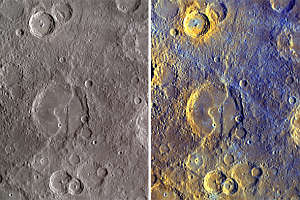 MESSENGER's color filter imaging capability reveals variations
MESSENGER's color filter imaging capability reveals variations
in color on Mercury too subtle for the human eye.
Photo credit: NASA/MESSENGERLike a snow-bird relative vacationing in warmer climate localities and sending back picture postcards of their trip, NASA's MESSENGER spacecraft has made yet another swing past our Solar System's innermost planet, Mercury. But, like the traveler who just can't seem to get enough sightseeing in, this was another whirlwind flyby set to the furious tempo of a camera snapping pics--about 1200 in all…
Did MESSENGER find anything new, since its first flyby back in January? Here are a few highlights:
• Prominent "ejecta" rays streaking out from several large craters--previously revealed only by radar imaging from Earth, now photographed for the first time.
• 30% more of Mercury's largely unexplored surface than had been revealed by the Mariner 10 flybys in the 70's and MESSEGNER's own first flyby last January (spacecraft--namely Mariner 10 and MESSENGER--have now imaged 95% of Mercury's surface).
• "Hyper-color" (my own word) imaging of surface features that reveal variations in color too subtle for the human eye to notice, providing information on soil and rock composition.
